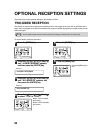
67
5
Chapter 5
SPECIAL FUNCTIONS
MEMORY
Your machine has a memory area that can be used to store both incoming faxes and outgoing originals.
● Approximately 120 pages of average content can be held in memory for transmission and reception. Less can be
held if any of the pages were scanned using fine or superfine resolution.
Substitute Reception into Memory
This is a back-up function that is automatically activated if your fax runs out of paper, the TD cartridge needs
replacement (See the Operation Manual for general information.), or the paper jams.
• If you received originals in memory because the fax ran out of paper, be sure to add paper which is the same size
as the paper previously used. If not, the original print-out size may not match the size of the printing paper.
PRINT HOLD MODE
PRINT HOLD MODE can be enabled to have received faxes held in memory instead of being automatically printed
out. Received faxes cannot be printed until a previously programmed passcode is entered. This mode is used to
ensure that received faxes are not misplaced or taken from the paper output tray by another person.
To enable this mode, a passcode must first be programmed. You will be prompted to enter this passcode when
printing received faxes that are held in memory. PRINT HOLD MODE cannot be enabled until a passcode has been
programmed. To program a passcode, see "PRINT PASSCODE" on page 68. To print out received faxes held in
memory when PRINT HOLD MODE is enabled, see "HOLD DATA PRINT" on page 69.
ENABLING PRINT HOLD MODE
Follow the steps below to enable PRINT HOLD MODE.
1
Press the [MENU] key.
2
Press the [ ] key ( ) or [ ] key ( )
until "4:USER PROGRAM" appears,
and then press the [ENTER] key.
Take care that the remaining memory does not become 7% or less, or you cannot receive any more faxes.
When the machine is idle, the LCD shows the stand-by memory available. (See "ABOUT THE LIQUID CRYSTAL
DISPLAY" (p.16))
Note
When PRINT HOLD MODE is enabled, the following reports are held in memory instead of being printed when
printing is executed.
• Reports that are printed as explained in "PRINTING OUT REPORTS" (p.85).
• Reports that are set to print as explained in "ACTIVITY REPORT AUTO LISTING" (p.88) and "PRINTING
TRANSACTION REPORTS" (p.89).
To print out reports held in memory, execute HOLD DATA PRINT (p.69).
Note
"4:USER PROGRAM"
Selection


















